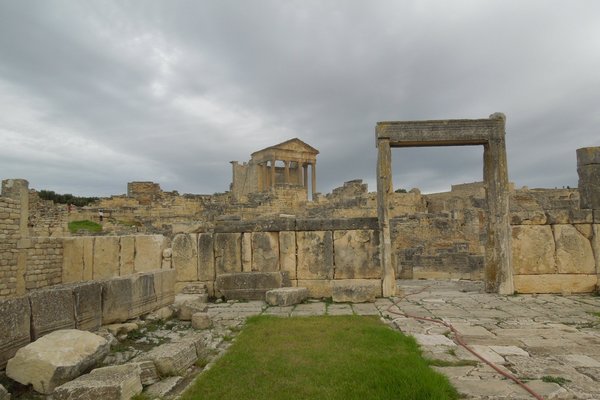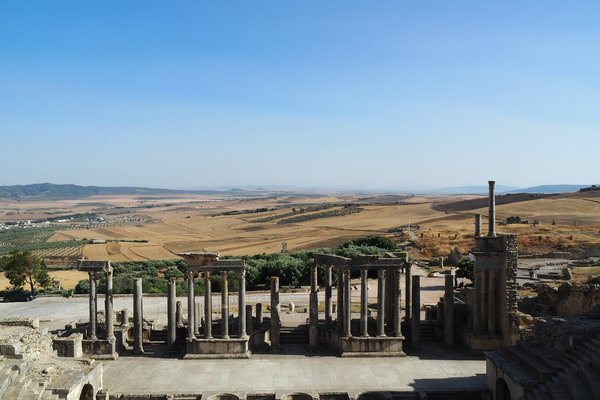Tunisia
Dougga/Thugga
Dougga/Thugga includes the archeological site of a small Roman provincial town and what was, probably, the first capital of the Numidian kingdom.
The Roman public and religious buildings were integrated with the old Numidian city. They deviated from the classic "blueprints" to take account of the local uneven terrain. Due to its remoteness and diminished importance since Byzantine times, the city is very well preserved. Epigraphs found at the site have made a decisive contribution to the decipherment of the Libyan language.
Community Perspective: it’s a vast site (allow 3 hours) with a number of almost entirely intact buildings, which has resulted in glowing reviews.
Site Info
Official Information
- Full Name
- Dougga/Thugga (ID: 794)
- Country
- Tunisia
- Status
-
Inscribed 1997
Site history
History of Dougga/Thugga
- 1997: Inscribed
- Inscribed
- Type
- Cultural
- Criteria
- ii
- iii
Links
- UNESCO
- whc.unesco.org
- Official
-
- inp2020.tn — Institut National du Patrimoine Thugga
- Related
-
- livius.org — Articles on ancient history: Thugga
- dougga.rnrt.tn — Dougga Portal
- en.wikipedia.org — Extensive Wikipedia page
All Links
UNESCO.org
- whc.unesco.org — whc.unesco.org/
Official Website
- inp2020.tn — Institut National du Patrimoine Thugga
Related Resources
- livius.org — Articles on ancient history: Thugga
- dougga.rnrt.tn — Dougga Portal
- en.wikipedia.org — Extensive Wikipedia page
Community Information
- Community Category
- Archaeological site: Ancient Rome
Travel Information
Tunisia hotspot
Recent Connections
-
Tunisia hotspot
112km / 2.5h by train and shared taxi -
Built in the 2nd century
"Dougga is the best preserved Roman sma… -
Triumphal Arches
There are two triumphal arches. That of…
Connections of Dougga/Thugga
- Trivia
-
-
On Banknotes
Dougga; 10 dinar; 2005See ii.mypivots.com
-
In the British museum
Cenotaph Inscription: played a significant role in deciphering the Libyco-Berber script, in which the Numidian language (Old Libyan) was written.[1] The language is however still not fully understood. The inscription once formed part of the Libyco-Punic Mausoleum (Mausoleum of Ateban) at Dougga in Tunisia, before it was removed in the mid nineteenth century and taken to London, where it is now in the British Museum's ancient Middle Eastern collection (wiki)See en.wikipedia.org
-
- History
-
-
Located in a Former Capital
Capital of Numidia until 46 BC -
Byzantine Empire and Civilization
Byzantine fortifications -
Berbers
Thugga's size, its well-preserved monuments and its rich Numidian-Berber, Punic, ancient Roman and Byzantine history make it exceptional (wiki) Mausoleum of Ateban is described as NumidianSee en.wikipedia.org
-
- Architecture
-
-
Mosaic art
a number of mosaics, including those in the building known as the house of Venus and in particular at the Aïn Doura Bath (wiki)
-
- World Heritage Process
-
-
Perfect Inscriptions
1997
-
- Religion and Belief
-
-
Nymphaeum
At the Temple of Caracalla's Victory in Germany: "It features a nymphaeum that dates to the reign of Commodus" (wiki)See www.alamy.com
-
- Human Activity
-
-
Festivals
"Once a year, in the spring, the Aïn-El-Hammam cisterns and the area around the Severus Alexander arch come alive with a colourful crowd, on the occasion of «Lella Mokhola’s» «zarda». This is well-established ceremony of a religious and sacred nature amongst the inhabitants of Dougga and its surrounding region." (see link)See www.inp2020.tn
-
Brothels
See looklex.com
-
Writing systems
Libyan, Punic, Greek, Roman inscriptions at the site led to the decipherment of the Libyan language -
Locations for playing sport
"has a circus designed for chariot racing, but it is barely visible nowadays" (wiki) -
Multilingual inscriptions
several Numidian-Punic bilinguals
-
- Constructions
-
-
Cisterns
"it possesses a remarkable assemblage of public buildings, most of them dating in their present form from the 2nd and 3rd centuries AD - .., public cisterns" (AB ev) -
Theatres and Opera Houses
Roman theatre -
Aqueduct
"An aqueduct leading to the city, located a short distance from the well-preserved cisterns, is amongst the best preserved examples of this type of structure on the territory of modern-day Tunisia." (wiki) -
Baths
"Three Roman baths have been completely excavated at Dougga; a fourth has so far only been partially uncovered." (wiki) -
Necropolises
the presence of a necropolis with dolmens, the most ancient archaeological find at Dougga (wiki) -
Triumphal Arches
There are two triumphal arches. That of Septimius Severus, built in all probability to commemorate the elevation of the city to municipium status, is much degraded, but the Arch of Severus Alexander still stands to a substantial height. (AB ev) -
Mausolea
Mausoleum of Ateban -
Hypogea
The hypogeum is a half-buried edifice from the 3rd century. It was erected in the middle of the oldest necropolis, which was excavated in 1913. The hypogeum was designed to house funeral urns in small niches in the walls; at the time of its discovery, it contained sarcophagi, which suggests that it was in use for a long time. (wiki) -
Latrines
You sit in a circle
-
- Timeline
-
-
Built in the 2nd century
"Dougga is the best preserved Roman small town in North Africa" - the Roman theatre dates from 168 or 169 CE, and is among the earliest of the major remaining Roman structures that mostly date from the 3rd century
-
- WHS Hotspots
-
-
Tunisia hotspot
112km / 2.5h by train and shared taxi
-
News
No news.
Recent Visitors
Visitors of Dougga/Thugga
- Alberto Rodriguez Gutierrez
- Alexander Barabanov
- Alexander Lehmann
- Ali Zingstra
- AmyAbroad
- Ana
- Aspasia
- Atila Ege
- BaziFettehenne
- Bill Maurmann
- Boj
- Bram de Bruin
- Christer Sundberg
- Christian Wagner
- Christravelblog
- Corinne Vail
- ctravel
- Dani Cyr
- Dimitar Krastev
- Dolemite92
- Dorejd
- Els Slots
- Erfe91
- Erik Jelinek
- Eva Kisgyorgy
- Evgenii
- Fan Yibo
- Feldhase
- Felicité
- Geert Luiken
- George Gdanski
- GeorgeIng61
- Grzegorz Andruszkiewicz
- Hammeel
- Harry Mitsidis
- H Beswick
- henryjiao18
- Iain Jackson
- Ian Cade
- Ivan Rucek
- Janos
- Jarek Pokrzywnicki
- Javier
- Jawnbeary
- Joel on the Road
- Jonas Kremer
- Juha Sjoeblom
- KarenBMoore
- Kbecq
- KentishTownRocks
- Krijn
- LaVale
- Liamps91
- Loic Pedras
- Luis Filipe Gaspar
- Malgorzata Kopczynska
- marcel staron
- marc Rouserez
- Marlies van Wolfswinkel
- Martin
- Martina Rúčková
- Marty
- MaxHeAnouBen
- MaYumin
- Michael Novins
- Mikko
- Mikko Syrjä
- Milan Jirasek
- Miloš Tašković
- Naim Y
- Nihal Ege
- PabloNorte
- Patrik
- Paul Schofield
- Petteri
- Philipp Peterer
- Priyaranjan Mohapatra
- Randi Thomsen
- Reza
- Roger Ourset
- Roman Bruehwiler
- Sergio Arjona
- Shandos Cleaver
- Ssong.x
- Stan
- Stanislaw Warwas
- Sutul
- Svein Elias
- Szucs Tamas
- Taotao Chen
- Tarquinio_Superbo
- Thomas Buechler
- Thomas van der Walt
- Tim Allen
- Timothy C Easton
- Viaje al Patrimonio
- voyager
- WalGra
- Westwards
- Wojciech Fedoruk
- Wo_ko
- YaroMir
- Zach
- Zoë Sheng
Community Reviews
Show full reviews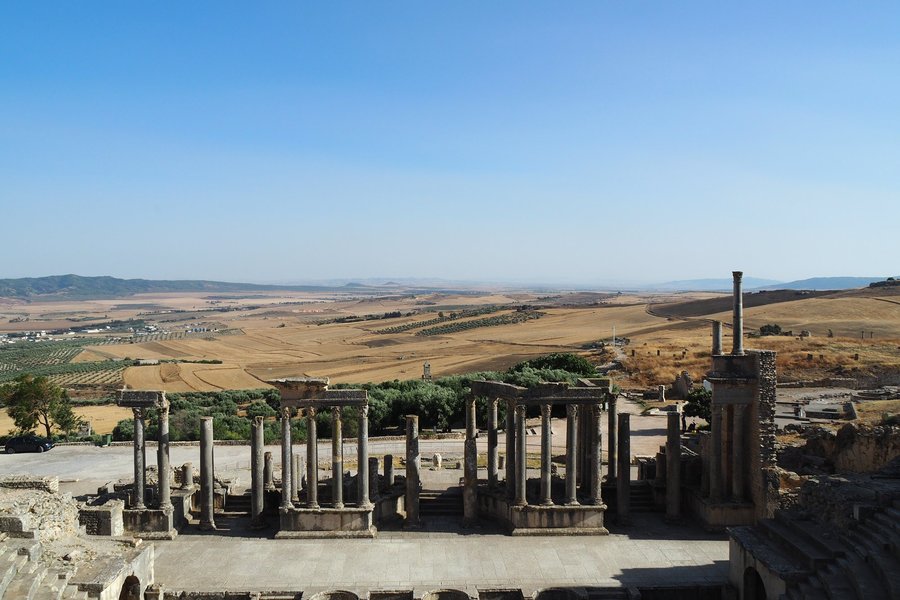
I reached Dougga from Ichkeul National Park, passing by to see the pottery of Berber women in Sejnane, a skill classified as Intangible Heritage, and arrived beyond Dougga-ville at the second entrance to the archaeological site, the lower one, as Zoé mentions. The guard informed me that since the ticket office was absent, I had to go to the upper entrance, which I did by going through the new town. A tourism police officer was waiting for me and asked me the following questions: where are you from, where are you going, how many are you, and how long do you plan to stay in Tunisia? He formally forbade me to camp in the site's parking lot. I agreed and went to sleep after the visit in the parking lot of the eponymous, secure hotel in town.
Once I had made my promise to the policeman, and with my ticket in hand (8 dinars), I went to the ruins. The tourist guides don't lie: the site is not lacking in majesty and you will be there all alone to fully experience its universal value. I didn't share exactly the same impression as Zoé: every time I am surprised and charmed by the difference, however slight, between two different sites from a similar period. And the setting in which this one nestles is simply magnificent, wherever you are: in the theater, in the forum, the capitol or the thermal baths.
What's also fun to discover is that some ancient sculptures were …
Keep reading 0 comments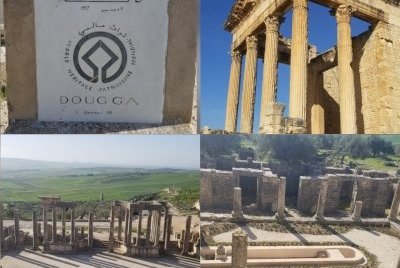
To repeat the previous reviewers opening remarks: this is one of THE best world heritage sites. Why only 4 stars? Because there are so many Roman ruins on the list already! You see one amphitheater you've seen them all, of sorts.
The site is so vast it will take you 3 hours to explore and to think they haven't excavated many sections including the stadium. It's so well preserved as it never had any wars and the people lived peaceful in Dougga until the 1960s(!) building new houses within the ancient walls. At that point the culture minister finally stepped in and asked to move their shit out and you only see the ruins now. There is no money for further excavations at this point but often the gardens are restored for visitors.
The most unique thing about the site is the use of a weather compass, showing the climate depending on the wind direction. It doesn't look clear on pictures so I didn't include one. Also the site shows that stones with donation inscription for temples (they were apparently not always provided by the Empire) were reused as other walls as needed, as part of a refurbishment of town I suppose.
Overall the well maintained buildings and historical significance of having survived so long is definitely worthy of inscription.
Two things you should note:
* There are TWO entrances and the southern one doesn't open until 10am. You can still arrive here and a …
Keep reading 0 comments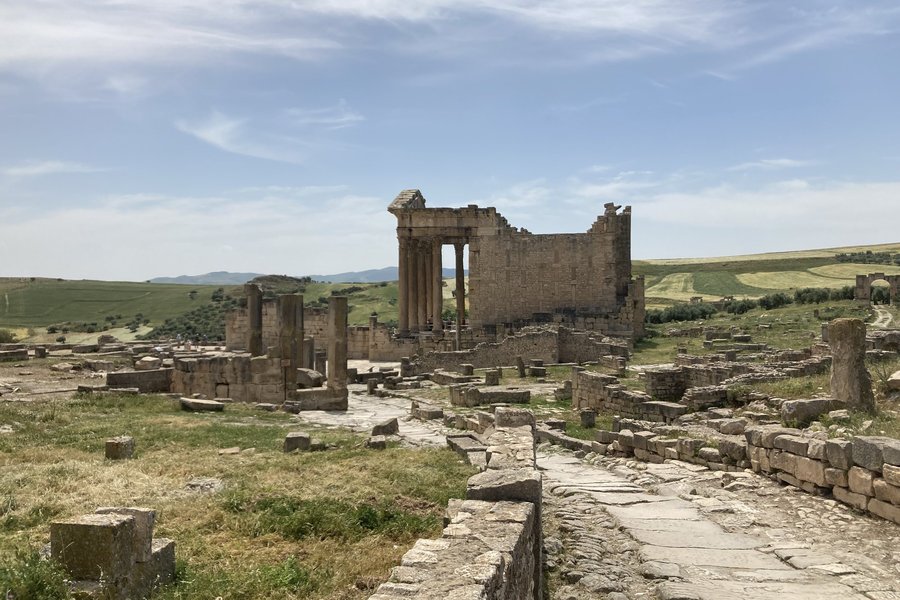
Getting to Dougga from Tunis was a bit of a trek considering the lack of transport, this may have been due to the religious holidays during Ramadan. The cheapest and quickest way of getting there is to go to the louage (shared taxi) station for Teboursouk and waiting for the taxi to fill up. Driving to Teboursouk took just over an hour (cost less than ten dinars) and a friendly local taxi driver was willing to take me the additional 10 kilometres for another 10 dinars.
The ruins at Dougga are magnificent! I was the only tourist there and explored the ruined city at my leisure. The capitol and many of the temple building are still relatively intact making for some very impressive views. Many of the homes still have much of their beautiful mosaic floors visible as well. It rained the day before so the mosaic tiles in the baths were wet bringing out the beautiful colours and shapes.
This is a truly impressive site well worth the visit. It is much better preserved than many similar sites in Europe. I also felt that it was much less touristy being furhter away from the coast. Its remoteness makes it difficult to reach but it is well worth a visit.
Keep reading 0 comments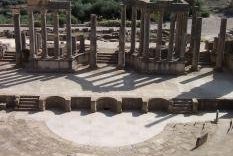
This is one of the best UNESCO sites I have visited, it is on a huge scale and very well preserved. The theatre and Capitol are almost entirely intact! And the size is so impressive. The remote location really adds to the appeal as well set on the side of a hill overlooking mountains and cornfields. If you are in Northern Tunisia this is a site really not to be missed.
To get there catch a bus or Loauge from Tunis to Terbosouq (these normally carry on through to Le Kef) from here the locals can help you to get to the site, but chances of bartering may be low as there seems to only be a few taxis around for tourists, so expect to pay about 15TD (€9) for a taxi/ caminette so the more people going the cheaper it will be! It is about 15km away and pretty remote so it is money well spent, you may be able to get it cheaper if you go in summer and try a bit of bartering!
Keep reading 0 comments
